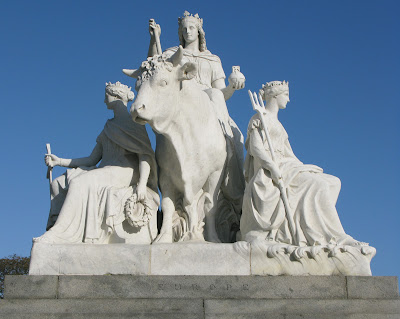 |
| Richelieu's tomb within |
The topics of this blog are Armand-Jean du Plessis, Cardinal Duke of Richelieu, and the IDEAL CITY built on his command next to his magnificent CHÂTEAU on the borders of Touraine, Anjou and Poitou, in France.
SEVEN NEW CLICKS!
Monday 31 October 2011
Roofscape of the cardinal's mausoleum in Paris
Labels:
architecture,
Paris,
Richelieuiana,
Sorbonne
EUROpean solidarity ....€
 |
| An allegorical statue of Europa - the white bull |
 |
| click on 'maps' on the right to find the statue's location |
Wednesday 26 October 2011
Friday 7 October 2011
Monday 3 October 2011
Mini pepper-pot towers
 |
| A seventeenth century engraving of the town, after Israel Sylvestre, looking from the West. |
Note the three little roofless turrets on the middle of the western town wall, set between the two pointy-roofed 'pepper-pot' gatehouses.
Yes, amazingly, they are still there, all three of them. With all the larger extensions into the moat, these three minor turrets are not so conspicuous as they were initially. They need to be sorted out! |
| This is the current state of the turret on the right (S) today. |
 |
| This is an axial view of the state of the central turret, hidden behind a tree. |
 |
| This is the central turret today, lurking behind the tree (see above), having been expanded into a house. |
 |
| This is the left-hand (N) turret looking onto the moat. |
 |
| This is the left-hand turret (N) from inside the wall, now used as a garage. |
***
The Marquis of Carabas
 |
| glass half-full; glass half-empty |
The story of Le chat botté - Puss in Boots - by Claude Perrault, from 1697.
The tale opens with the third and youngest son of a miller receiving his inheritance — a CAT. At first, the youngest son laments, as the eldest brother gains the mill, and the middle brother attains the mules. The feline is no ordinary cat, however, but one who requests and receives a pair of boots. Determined to make his master's fortune, the cat bags a rabbit in the forest and presents it to the king as a gift from his master, the fictional Marquis of Carabas. The cat continues making gifts of game to the king for several months.
One day, knowing the king and his daughter are traveling by coach along the riverside, the cat persuades his master to remove his clothes and enter the river. The cat disposes of his master's clothing beneath a rock. As the royal coach nears, the cat begins calling for help in great distress, and, when the king stops to investigate, the cat tells him that his master, the Marquis, has been bathing in the river and robbed of his clothing. The king has the young man brought from the river, dressed in a splendid suit of clothes, and seated in the coach with his daughter, who falls in love with him at once.
 |
| Puss brokes to the Ogre - an engraving by Gustave Doré |
The cat hurries ahead of the coach, ordering the country folk along the road to tell the king that the land belongs to the "Marquis of Carabas", saying that if they do not he will cut them into mincemeat. The cat then happens upon a castle inhabited by an ogre who is capable of transforming himself into a number of creatures. The ogre displays his ability by changing into a lion, frightening the cat, who then tricks the ogre into changing into a mouse. Once that change is complete, the cat pounces upon the mouse and devours it. The king arrives at the castle which formerly belonged to the ogre, and, impressed with the bogus Marquis and his estate, gives the lad the princess in marriage. Thereafter, the cat enjoys life as a great lord who runs after mice only for his own amusement.
The tale is followed immediately by two morals:
"one stresses the importance of possessing industrie and savoir faire while the other extols the virtues of dress, countenance, and youth to win the heart of a princess."
 |
| The etiquette on the bottle of 'Carabas' - Santé! - |
Le Carabas is one of the names of the wines made by François Plouzeau in a vineyard, La Garrelière, not far from the cardinal duc's Ideal Town of Richelieu, above the village of Razines. While glugging a few glasses of François' white delight, Henri Proust was puzzled by its name: CARABAS.
Above, we publish the back-story of this top tipple.
***
Labels:
Cats,
Engravings,
Food and Drink,
Literature
Subscribe to:
Posts (Atom)




















